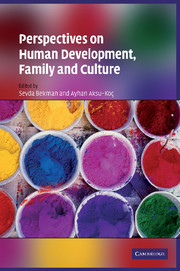Book contents
- Frontmatter
- Contents
- List of figures
- List of tables
- List of contributors
- Preface
- Foreword
- Selected international publications by Çiğdem Kağıtçıbaşı
- I Cultural and cross-cultural psychology: selected perspectives
- II Development in the family context
- III Culture and self
- IV Social change, family, and gender
- V Induced change
- 18 Adapting intervention programs for use across societies: Between valid transfer and cultural imposition
- 19 Design of culturally-appropriate developmental interventions
- 20 Designing, implementing, sustaining, and evaluating idiocultures for learning and development: The case study of the Fifth Dimension
- 21 Intervention programs to improve cognitive skills
- 22 Pro-poor approaches to using technology for human development: Monitoring and evaluation perspectives
- Epilogue
- Subject Index
- Author Index
- References
19 - Design of culturally-appropriate developmental interventions
Published online by Cambridge University Press: 04 August 2010
- Frontmatter
- Contents
- List of figures
- List of tables
- List of contributors
- Preface
- Foreword
- Selected international publications by Çiğdem Kağıtçıbaşı
- I Cultural and cross-cultural psychology: selected perspectives
- II Development in the family context
- III Culture and self
- IV Social change, family, and gender
- V Induced change
- 18 Adapting intervention programs for use across societies: Between valid transfer and cultural imposition
- 19 Design of culturally-appropriate developmental interventions
- 20 Designing, implementing, sustaining, and evaluating idiocultures for learning and development: The case study of the Fifth Dimension
- 21 Intervention programs to improve cognitive skills
- 22 Pro-poor approaches to using technology for human development: Monitoring and evaluation perspectives
- Epilogue
- Subject Index
- Author Index
- References
Summary
About five years ago I would not have thought that I would be worrying (let alone writing) about cultural appropriateness of interventions. After about twenty years of doing research in the US, I believed that science was science, and theory was theory no matter where one might be located. Professor Kağıtçıbaşı should have been, but was not, dismayed at my attitude. She merely suggested that there may be other points of view, and continued to collaborate with me in various research projects. I am deeply grateful for that opportunity.
Introduction
Developmental interventions often cite an effort to make an intervention “culturally appropriate” or “culturally sensitive,” and many applied developmental scientists view such appropriateness or sensitivity as a desirable property of interventions. At the same time, “cultural appropriateness” remains largely undefined, unmeasured, and consequently of untested virtue. We, the developmental scientists, often refrain from conceptually discussing or operationalizing “cultural appropriateness.” Hence, “cultural appropriateness” remains a slogan rather than a well-defined and measured property of developmental interventions.
The lack of a conceptual definition and an operationalization of cultural appropriateness of interventions are not without consequences. An effort to develop a culturally appropriate intervention without well articulated conceptual guidance may lead to well-meaning but perhaps unnecessary or even undesirable modifications of an intervention, without the possibility of evaluating whether those modifications were cost-effective or whether they contribute to the effectiveness of the intervention. Furthermore, cultural appropriateness may be a quantitative, rather than a qualitative, property.
- Type
- Chapter
- Information
- Perspectives on Human Development, Family, and Culture , pp. 314 - 330Publisher: Cambridge University PressPrint publication year: 2009



